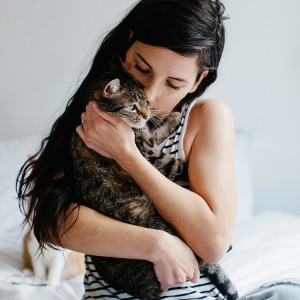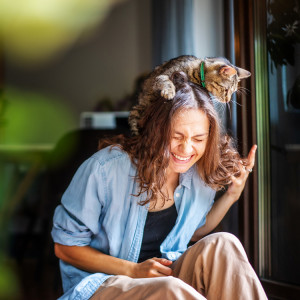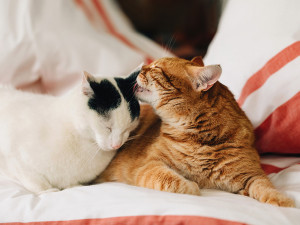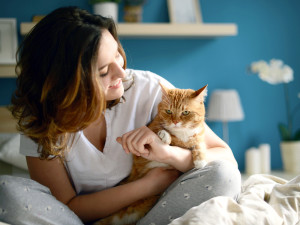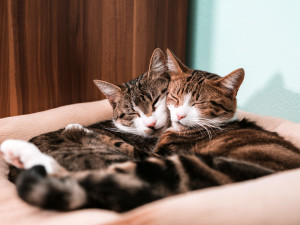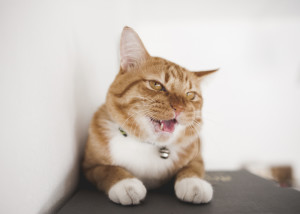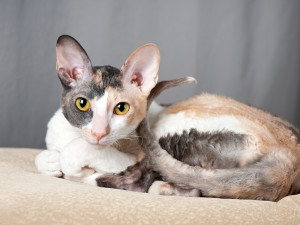Can Cats Sense Sadness? A Guide to Their Emotional Recognition
Their reactions may surprise (or perplex) you.

Share Article
In This Article:
Can Cats Sense That You’re Sad? How Cats Perceive Human Emotions The Historical Bonds Between Cats and Humans What Your Cat Does When They Sense You’re Sad
Have cats gotten a bad rap? Dogs are frequently the pets most associated with empathy and sympathy, but cats can feel what their pet parents feel, too. Their reactions may not always be the same — or what you’re expecting — but just know you’re not alone in your feelings when your kitty is around. In fact, the mere presence of your cat may help you get through whatever it is you’re struggling with.
Read on for more details on how your cat may perceive you’re going through a tough emotional time, as well as why they react the ways they do.
Main takeaways
Cats can sense changes in our emotional states.
Their reactions are both instinctual and learned from the past times we were sad.
Facial expressions, body language, tone, and volume are just some of the emotional cues they can pick up on.
They may act in ways that seem supportive, or choose to keep their distance.
Regardless of their reactions when we’re sad, they’re wonderful to have around.
Can cats sense that you’re sad?
You’ve probably noticed your cat’s response to your different moods. In some cases, they may show more affection, as if they’re offering support. Other times, they may keep their distance. Some cats can even have a fearful or aggressive response to certain human emotional states. Let’s crack the code about why that is and what it means.

How cats perceive human emotions
Keep in mind, cats don’t experience emotions the same way people do. They likely don’t have the same complex layers of emotion, such as frustration leading to spite, anger leading to rage, or intense grief over a life that ended too soon.
Instead, they live more “in the moment.” They aren’t reflecting on past choices or worrying about the future. They’re experiencing this moment in time and reacting to it.
But they can certainly still feel things. We’ve seen our cats scared during a medical procedure, lamenting a pet or person who has passed, maybe feeling a little tense or seemingly jealous over another pet. How, then, do our cats recognize and react to what we’re feeling emotionally? It’s pretty simple, really. They’re learning through experience.
Cats sense things like our facial expressions, how our voice changes, what we’re doing at that moment, and how receptive we are to them. If they’ve experienced this before, they’ll think back on what happened the last time we were in this state. Then they respond accordingly. That may be, “Hey, this is a good time to snuggle up with my human,” or, “Uh oh, that’s bad news. I should go in the other room.”
Facial expressions
Studies have shown that cats can recognize facial cues. It’s important to remember that there are other factors at play as well — like what’s happening in the environment around them or what our tone of voice is — that can influence how they react. But it makes sense that they notice changes in our faces when we’re sad, angry, and so on, because that’s where we are most expressive.
Voice and auditory cues
Just as children learn the difference between their parents’ happy and “you’re in so much trouble” voices, cats can also pick up on those differences in tone and volume. Even the language you use can be a cue for your cat. If you use their full name (yes, some pet parents give their cats full names) or yell out an expletive every time they do something you don’t like, they’ll remember it. They take in all of this information when trying to determine if, when, and how to interact with us, including when we’re sad.
Behavior and disposition
Cats are body language experts. It’s a key form of communication. Of course, they’re going to pay attention to our body language as well. We carry ourselves differently when we’re sad. We may be quieter, smaller (as we slump or curl up), and more open to calming behaviors like gentle petting. All of these are an invitation for your cat — and less intimidating than you running around getting things done, or screaming because you just stubbed your toe.
The historical bonds between cats and humans
There’s no denying our love for cats. More than 40 million American households include at least one cat. They invited themselves inside and became part of our homes over 10,000 years ago. We have a long history together. That’s a lot of years to form a bond and fall in love.
The impact of strong bonds
The bonds we share with cats meet so many of our needs. They provide something we can care for. They care for us. That sense of connection can be what gets us off the couch for a play session on a bad day or out of our heads when we’re overwhelmed. They offer companionship and accept us when we’re not our best selves. You can’t put a price on that.
What might your cat do when they sense you are sad?
This is where it gets a little tricky. We haven’t invented the magic machine that lets us climb inside our cat’s brain to figure out why they do what they do. To come up with our best guesses, have to combine what science can tell us about cat emotions (which isn’t much, because it’s not the top priority for most scientists), what we know about them as animals, and what we experience when we’re with them.
Comfort you
Every one of us wants to imagine our cat hearing our soft sobbing and rushing over to comfort us. And yes, some cats may do that. They could intentionally try to offer support. There’s nothing better than cat comfort.
Spend more time around you
It’s also possible that your current state is conducive to a nice, long nap under the blanket you’re cocooning in, and that you’re unlikely to leave anytime soon. If you’re up and moving, your cat will be more active. If you’re cozy on the couch, they’re generally doing the same. They feed off the energy in the room.
Ignore or avoid you
This is not as harsh as it sounds. Remember that cats are animals: They act on instinct. If you’re behaving in a way that is unsettling or makes them nervous, they’ll keep their distance. If it’s a behavior that hasn’t benefited them in the past, or maybe you pushed them away as you dealt with your sadness, they won’t necessarily have a reason to respond. It’s just their natural reaction to a new or non-beneficial experience.
Does a cat help when you are sad?
Is a snuggle when you’re sad their way of offering support, or is seeing you quiet and curled up on the couch an invitation to rest with you? Who knows — but also, who cares? A furry snuggle is a furry snuggle, regardless of the deeper meaning behind it.
Studies show that having pets improves mental health. How could it not? Even if they bite you while you’re crying, they’re still pretty fantastic to have around when you’re feeling blue.
References
Brooks, Helen Louise, et al. “The Power of Support from Companion Animals for People Living with Mental Health Problems: A Systematic Review and Narrative Synthesis of the Evidence.” BMC Psychiatry, vol. 18, no. 1, 5 Feb. 2018, www.ncbi.nlm.nih.gov/pmc/articles/PMC5800290opens in new tab, https://doi.org/10.1186/s12888-018-1613-2opens in new tab.
Megna, Michelle. “Pet Ownership Statistics and Facts in 2023 .” Forbes, 25 Jan. 2024, www.forbes.com/advisor/pet-insurance/pet-ownership-statisticsopens in new tab.
Quaranta, Angelo, et al. “Emotion Recognition in Cats.” Animals, vol. 10, no. 7, 28 June 2020, p. 1107, https://doi.org/10.3390/ani10071107opens in new tab.
Zax, David. “A Brief History of House Cats.” Smithsonian Magazine, 30 June 2007, www.smithsonianmag.com/history/a-brief-history-of-house-cats-158390681opens in new tab.

LeeAnna Buis, CFTBS, FFCP
LeeAnna Buis has adored cats her entire life and thought she knew them inside out and sideways. But it wasn’t until she worked with a feline behavior consultant that she fully understood how incredible, complicated, and inspiring they really are. She made a career change, starting the certification process to become a behavior consultant right away. She discovered what unique, fascinating, complex creatures cats are and knew this was what she wanted to do with her life — help others on a similar journey to truly knowing, loving, and appreciating their cats.
LeeAnna earned her certification through Animal Behavior Institute, where she received the certified feline training and behavior specialist (CFTBS) designation.
Related articles
Why Is My Cat Suddenly Clingy?
They’re never far away, but you’d like a little distance.
![Two tabby cats cuddling each other with their eyes closed]()
Cats Aren’t Loners, After All
Cat behaviorist Kristiina Wilson on the importance of socializing cats.
![Woman trying to hug a grumpy orange cat.]()
People Are Bad at Knowing When Their Cats Are Pissed, New Study Says
We can tell when cats are happy, but we’re pretty bad at figuring out when they’re not.
![Two tabby cats in embrace lying in cushion.]()
What Are Cat Pheromones and How Do They Work?
Communication is key, and pheromones are your cat’s version of DMs.
![a cat making a strange face with its mouth open.]()
Is Your Cat Judging You?
That disapproving sneer is actually the “Flehmen response.” A cat behaviorist explains how to read cats’ lips.
![Cornish Rex cat laying down on a pillow]()
The Cat Breed-Behavior Connection
Which cats are more likely to have stranger danger? Bite the hand that feeds them? Do the zoomies? Scientists studied 5,700 pet cats and discovered some interesting traits.

